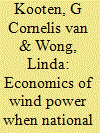|
|
|
Sort Order |
|
|
|
Items / Page
|
|
|
|
|
|
|
| Srl | Item |
| 1 |
ID:
094901


|
|
|
|
|
| Publication |
2010.
|
| Summary/Abstract |
Power interruptions are a typical characteristic of national grids in developing countries. Manufacturing, processing, refrigeration and other facilities that require a dependable supply of power, and might be considered a small grid within the larger national grid, employ diesel generators for backup. In this study, we develop a stochastic simulation model of a very small grid connected to an unreliable national grid to show that the introduction of wind-generated power can, despite its intermittency, reduce costs significantly. For a small grid with a peak load of 2.85 MW and diesel generating capacity of 3.75 MW provided by two diesel generators, the savings from using wind energy (based on wind data for Mekelle, Ethiopia) can amount to millions of dollars for a typical July month, or some 5.5-17.5% of total electricity costs. While wind power can lead to significant savings, the variability of wind prevents elimination of the smaller of two diesel units, although this peaking unit operates less frequently than in the absence of wind power.
|
|
|
|
|
|
|
|
|
|
|
|
|
|
|
|
| 2 |
ID:
125558


|
|
|
|
|
| Publication |
2013.
|
| Summary/Abstract |
Existing literature indicates that theoretically, the earth's wind energy supply potential significantly exceeds global energy demand. Yet, only 2-3% of global electricity demand is currently derived from wind power despite 27% annual growth in wind generating capacity over the last 17 years. More than 95% of total current wind power capacity is installed in the developed countries plus China and India. Our analysis shows that the economic competitiveness of wind power varies at wider range across countries or locations. A climate change damage cost of US$20/tCO2 imposed to fossil fuels would make onshore wind competitive to all fossil fuels for power generation; however, the same would not happen to offshore wind, with few exceptions, even if the damage cost is increased to US$100/tCO2. To overcome a large number of technical, financial, institutional, market and other barriers to wind power, many countries have employed various policy instruments, including capital subsidies, tax incentives, tradable energy certificates, feed-in tariffs, grid access guarantees and mandatory standards. Besides, climate change mitigation policies, such as the Clean Development Mechanism, have played a pivotal role in promoting wind power. Despite these policies, intermittency, the main technical constraint, could remain as the major challenge to the future growth of wind power.
|
|
|
|
|
|
|
|
|
|
|
|
|
|
|
|
| 3 |
ID:
125507


|
|
|
|
|
| Publication |
2013.
|
| Summary/Abstract |
British Columbia's energy policy is at a crossroads; the province has set a goal of electricity self-sufficiency, a 93% renewable portfolio standard and a natural gas development strategy that could increase electricity consumption by 21 TWh to 33 TWh. To ascertain the BC's supply position, a mathematical programming model of the physical workings of BC's hydroelectric generating system is developed, with head heights at the two dominant power stations treated as variable. Using historical water inflow and reservoir level data, the model is used to investigate whether BC is capable of meeting its self-sufficiency goals under various water supply and electricity demand scenarios.
|
|
|
|
|
|
|
|
|
|
|
|
|
|
|
|
|
|
|
|
|